When scale-ups consider using TV advertising for the first time, it’s a decision that can be riven with uncertainty. So here’s some advice and data to help, including a new analysis of the performance of 550 TV ads by 200 new-to-TV brands by System1 Group. It reveals some lessons for scale-ups and a worrying problem: techniques common in the production of online video could be limiting the effectiveness of new TV advertisers’ ads.
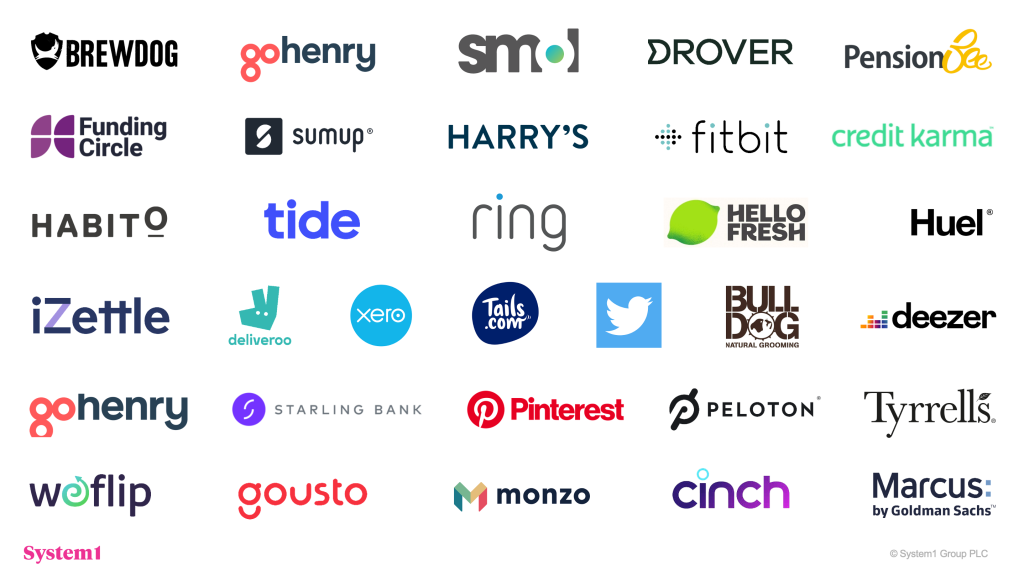
Deciding to use TV advertising for the first time can be a remarkably emotional decision. It’s often a natural next step for scale-ups needing to reach a much wider audience to take their growth to the next level. But concerns about TV’s cost, effectiveness, accountability, the need to hire agencies, even a marketing team’s lack of experience can come to the fore, making it feel like one of the riskiest decisions in a brand’s early life.
New brands can go through a phase when they see the success of their performance marketing level off. They may see increasing customer acquisition costs and decreasing efficiency of their acquisition channels as they reach saturation point. Layering in mass reach advertising can help them achieve a step-change in growth, as illustrated in the chart below by econometrician Dr Grace Kite and me.
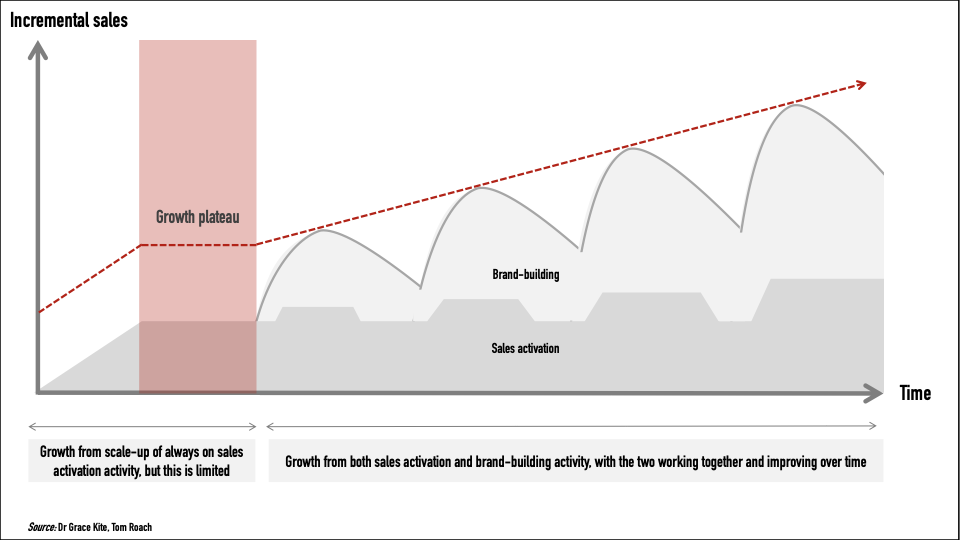
Using TV at this point is not the only choice of course, and I’m not someone who believes no brand has ever been built without it. But I suspect many brands reach this decision point, consider the pros and cons, but choose not to go for it, for a whole host of reasons, some perfectly rational, some less so.
We’re all susceptible to our perceptions of TV as an advertising channel being shaped by what we hear in the mass and business media, which is often that it’s ‘dead’ or ‘dying’, and there’s not much any of us can do about that regardless of the hyperbolic nature of those kinds of claims. But a common problem that we can do something about is conflating our own media behaviours with our audience’s, resulting in that persistent fallacy, ‘no-one watches TV any more do they?’
Live TV viewing is certainly declining dramatically, especially amongst younger audiences, but the total reach of all kinds of TV – whether live, recorded, or broadcaster VOD, being viewed on devices and screens of every size and type, has actually remained remarkably stable over the last decade in the UK. In 2019 it was still reaching virtually everyone in the UK every week – 95.5% of all adults and 91% of all 16-34s every week, even when you exclude the subscription platforms[i].
And in terms of all the video advertising people are exposed to in a day, TV advertising still accounts for by far the largest proportion people are exposed to – 93% of the video ads that the average person sees in the UK, and 84% of the video ads younger people see, are TV ads. That’s 18mins of video ads a day in the UK on average, and 12mins for 16-34s. So TV advertising’s still very much alive, it’s digital, and it’s having babies.
You also hear people saying TV ‘doesn’t work anymore’. In fact, TV remains the most effective growth-driving channel overall, the most effective in the longer term, and the second most effective in the first two weeks of a campaign, according to ‘Demand Generation’, a study commissioned by Thinkbox and conducted by Mediacom, Wavemaker and the econometrics agency, Gain Theory, which looked at how different channels contribute to sales, and over what timescale their effects happen[ii].
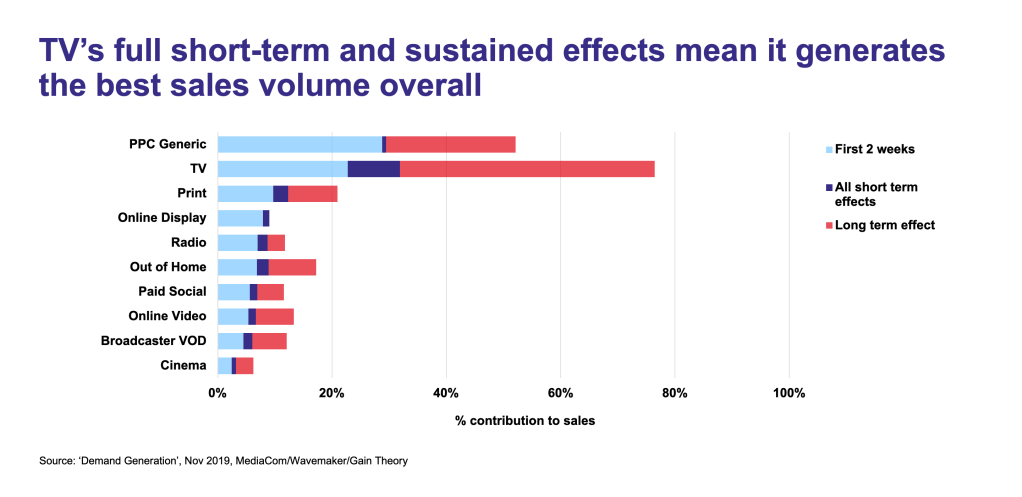
And not only is TV still the most effective channel overall, but it can have the greatest incremental impact of any channel on all your other channels too – on average it can boost the impact of your generic search by +8%, your online video and VOD by +20%, and your paid social by +31%.

Monzo bank, for example, having at launch claimed not to believe in any kind of paid advertising, decided to use TV for the first time in 2019 to achieve a step-change its growth, and saw massive, instant uplifts in search, as well as ‘insane’ growth in app downloads and account openings[iii].
And whilst it’s sometimes the case that the cost of TV media can be the largest single bill of any kind that a digital native brand with no tangible assets has yet had to pay, it’s a fallacy that TV advertising is much more expensive than other channels. In the UK, TV’s cost per thousand is c£6 or 0.6p for a single impression, so not far off a typical CPT on Facebook. And a benefit of TV ads is the extra seconds of attention they typically get from viewers vs other video – around 4.5x the seconds of attention the average facebook infeed ad gets[iv].
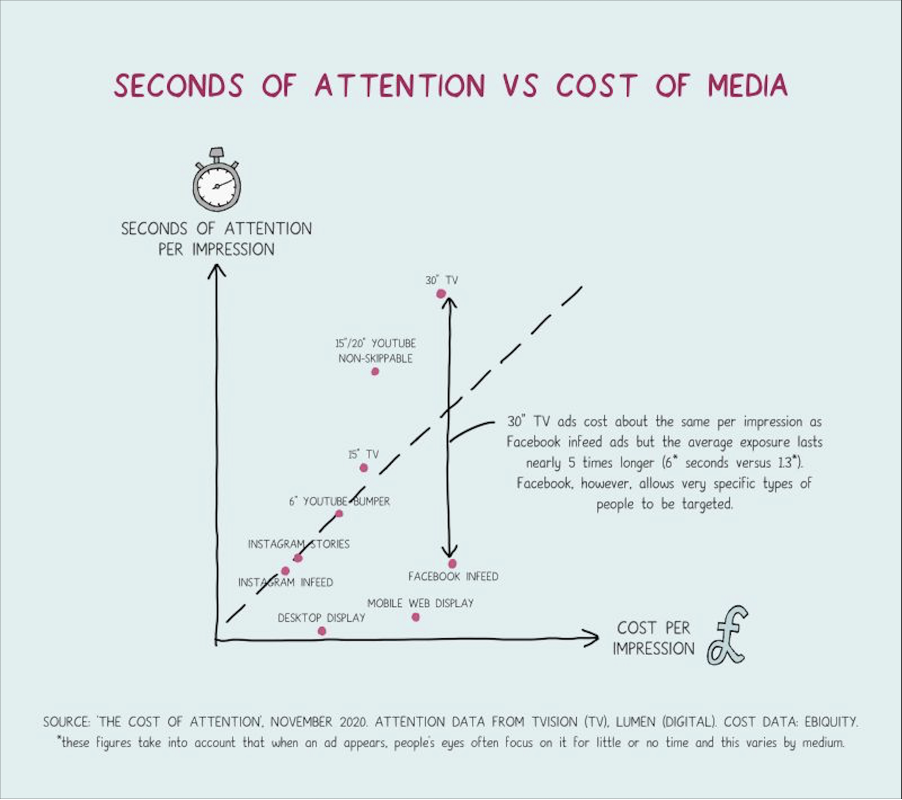
In 2019 in the UK, over 900 advertisers spent less than £50k on TV advertising across the year. In the same year a total of 837 new brands advertised on TV, of which over 600 spent under £20k[vi]. At the other end of the spectrum, only around 250 brands spent over £5m. And to make it even more accessible, all the commercial broadcasters are experimenting with different ways of incentivising new brands onto their platforms, helping hundreds of brands make the step every year[v].
One specific area of concern can be from teams who are used to getting an immediate read on the customer acquisition costs of every channel. And whilst it’s perfectly possible to monitor TV’s immediate sales and other impacts, because TV has unusually long-lasting effects, with around c60-70% of sales being generated in the weeks and months following exposure, TV spend can appear inefficient if its full effects aren’t factored in. And to do that you will need the right data, marketing analytics partners, and crucially time and patience, which can be in limited supply for brands in a hurry. Fortunately, some providers of marketing performance analytics are innovating to help make their offerings faster, better, cheaper.
When a brand decides to use TV, it can also be the first time it’s engaged external agencies. And if founders are involved, hiring an agency can feel to them like they’re handing over their baby to a childminder for the first time, with all the potential for tension and tantrums that implies. In fact, there’s actually a neuroscience study which shows that founders react to a visual of their brand’s logo with the same emotional intensity as when they’re shown photos of their own babies.[vii]
Aside from media and agency costs, the cost of producing video assets to air on TV can also seem prohibitive and it’s true they’re usually greater than the cost of producing a video for social channels. But add up all the smaller individual costs for a year’s worth of videos, and you can easily surpass the c£50k entry level cost of producing a TV asset that will give you at least a year’s worth of use.
So hopefully that’s some useful context and data to help inform the debate for brands weighing up the pros and cons of starting to deploy TV advertising today.
So what can scale-ups learn from other scale-ups who’ve already taken the plunge?
As it’s such a significant moment, and one that can also seem so difficult creatively, I thought it would be interesting to explore the creative performance of scale-ups when they take their first steps onto TV.
Are marketers right to be nervous? Do ads by scale-up brands perform any worse than ads by brands who’ve been doing it for years? Do they get better with experience? Do their inexperience or lack of big budgets show? Are ads by new-to-TV advertisers better at driving short-term performance than long-term, perhaps because of the skew in their experience towards social and performance channels? Do they bring with them any good or bad habits from the channels they’re most used to creating video content for? What advice could help scale-ups get the most out of going on TV?
To try and answer some of these questions, I approached System1 Group, who test all the breaking TV ads in most categories in the UK and the US, so have data on the performance of thousands of ads including those by start-ups and scale-ups. They helped provide the data that follows.
Matching a list of c10,000 ads from System1’s ad testing database with BARB’s list of new TV advertisers from 2014-2019 in the UK, gave me a list of 200 new-to-TV advertisers for 2014-2019, and performance data for 550 ads, including 193 year1 ads, 120 year2 ads, and 86 year3ads.
This list of 200 new-to-TV brands covers every category. It reads like an A-Z of scaleups in the UK from the last 5 years, including Brewdog, Bulldog, Deliveroo, Drover, Fitbit, Funding Circle, Go Henry, Habito, Harry’s, Huel, iZettle, Marcus, Monzo, Pinterest, Starling, Tide, Twitter, Tyrrell’s, Weflip and Xero.
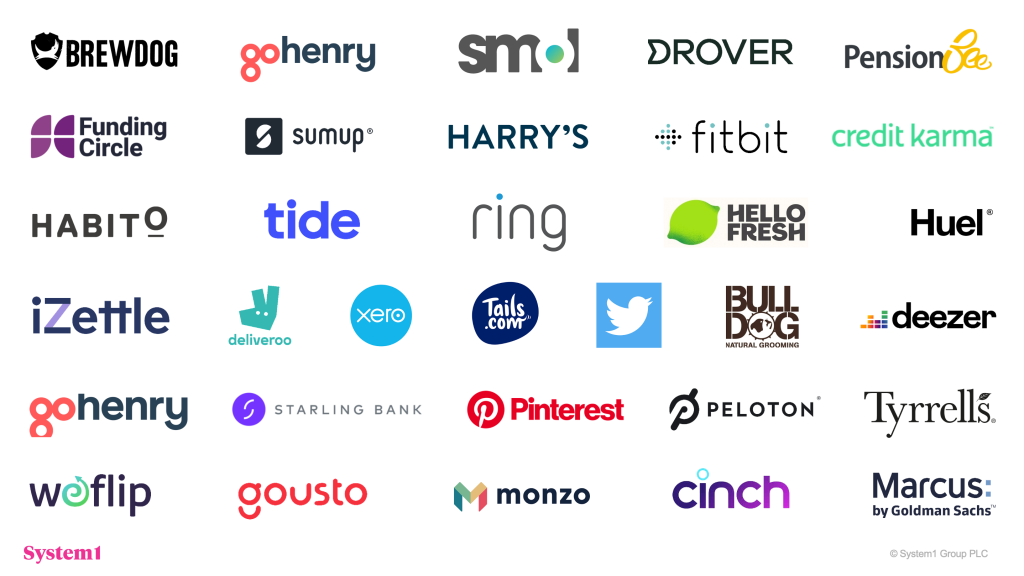
The first thing we found was that ads by new-to-TV brands tend to perform worse than ads by established advertisers. Their 1st year TV ads only average 1 star on System1’s 5-star scale which measures emotional impact and is predictive of long-term sales success, vs the 2 stars that the average UK ad gets.

When you look at the distribution of the scores, many more 1st year ads got 1 star on average vs established advertisers. Far fewer achieved 2 and 3 stars, only one achieved 4 and none achieved 5. For new-to-TV advertisers both the ‘floor’ and the ‘ceiling’ were lower than for established advertisers.

The only new-to-TV year 1 advertiser to achieve 4 stars was Elizabeth Shaw chocolates. And their first foray into TV was indeed hugely successful: they saw +268% sales uplift in the regions where TV was used[viii].
The 193 year1 ads by new-to-TV advertisers perform worse on average on all three of System1’s key metrics: long-term impact (their ‘Star’ rating), short-term sales impact (their ‘Spike’ rating) and branding (their ‘Fluency’ rating).
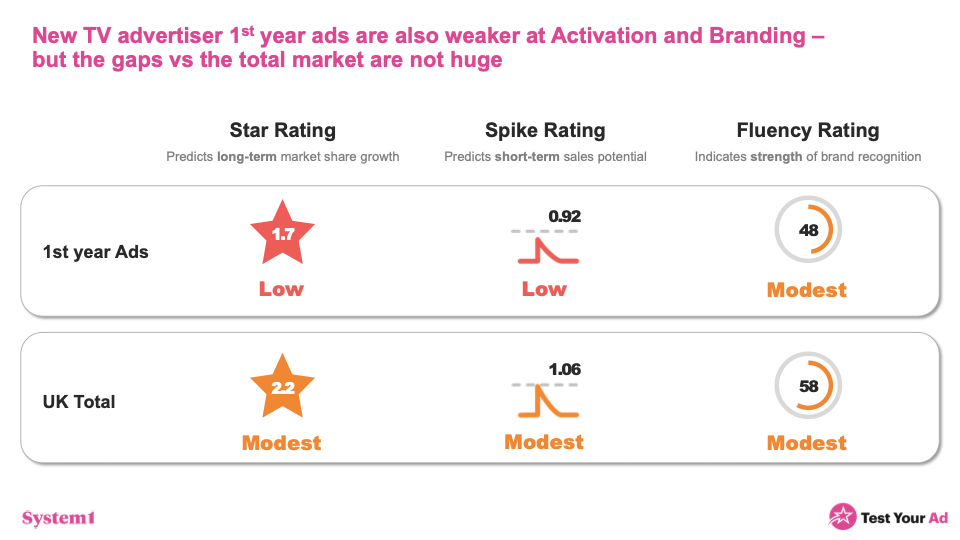
But to be fair they’re not much worse than established advertisers, and actually after 3 years they’re on a par with the average. Whilst new TV advertisers show no improvement in their 2nd year of TV advertising, by years 3 and 4 on average they have improved up to the level of established advertisers. So whilst some existing advertisers may have decades more experience, on average they only have a 3 year head start in performance terms.
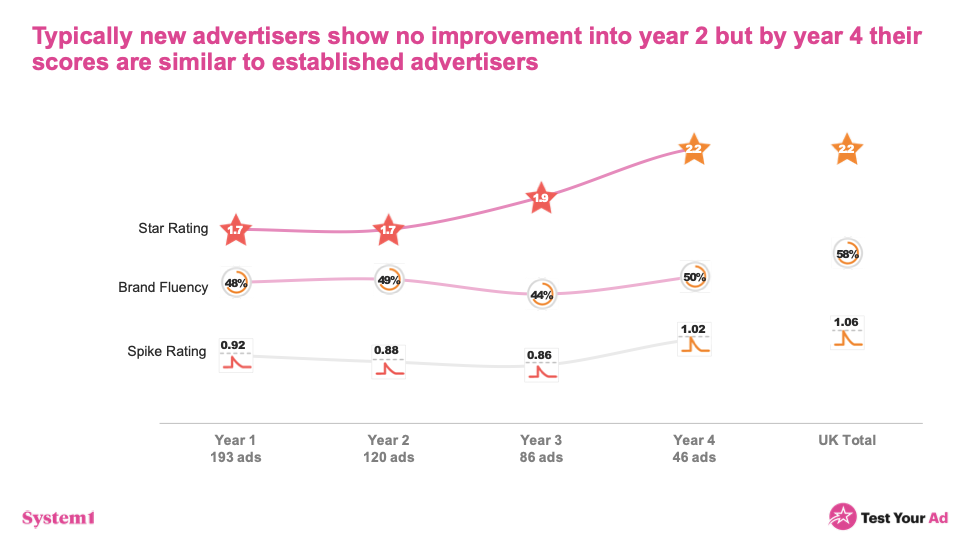
Building lasting brand memories by making an emotional impact on viewers is one of the core strengths of TV advertising, and this is where the greatest improvement happens in years 3-4 for new-to-TV advertisers, perhaps as they improve the capabilities, creative and craft skills required to get the most from the medium.
The lessons from this for scale-ups are these: hire people with experience and/or appoint an agency, rather than attempting to go it alone; don’t expect perfection from the get-go; don’t imagine you’re going to see exponential growth like in your start-up days; keep what’s working from your initial attempts; aim to create a greater emotional impact; stick with it; and the commercial impact of your TV advertising should improve significantly by years 3 and 4.
To try and shed light on why the performance of ads isn’t as strong in the first couple of years we looked at the type of emotions they evoke. The results were clear: in years 1-2 they tend to cause too neutral a response from viewers and not enough happiness. It’s only by year 4 that they’re evoking good levels of happiness – the emotional response most predictive of long-lasting commercial impact.

It’s possible that there is some survivorship bias at play here (ie with some better advertisers continuing to use TV but not improving over their initial years, and some worse ones dropping out, so taking the average up over time). But when we looked at the advertisers in the dataset who develop new ads in each of their first 3 years, they also improve, on average, exactly in line with the total picture.
When we explored the performance of ads from different sectors, we saw the greatest under-performance from new Financial Services, Automotive and Tech advertisers. Household and Food & Drink brands performed a bit better, albeit still under-performing vs established advertisers in their categories.

It’s possible that new FS, Automotive and Tech brands under-perform the most because it’s these categories that are responsible for the most disruptive and novel business models and propositions, and so perhaps new brands in these categories feel a greater need to explain their propositions in detail to the audience, which can limit their emotional impact. For many of these ads their TV scripts can seem like they’ve been copied directly from their investor pitch decks – essentially an explanation of the customer issue followed by an extended product demo. This is understandable but it suggests a failure to find creative ways to engage the audience emotionally, which new brands should see as an important outcome and not simply a nice-to-have.
Another thing we explored was whether new-to-TV advertisers perform better on short-term impact than on System1’s predictor of long-term commercial impact. One hypothesis here being that some new TV advertisers may perhaps intentionally sacrifice long-term performance to achieve maximum impact in the short term. It’s a common debate, with voices on the marketing team often arguing for creative with a short-term bias: “we need to be a little less creative, more focused on the product, to establish this new category and explain the proposition with consumers – we can get more creative and ‘emotional’ in the future once we’ve done that”.
The data suggests that’s a false choice. You’ll see from the chart below that a significant proportion of the ads (just under 20%) do manage to perform on both short-term and long-term impact. So you don’t have to sacrifice long-term impact in order to achieve short-term impact even if you’re a new brand trying to establish yourself. Interestingly you don’t get many ads in the extreme bottom right of the chart: if you do really well on long-term impact, you’re more likely to also perform well in the short term too.

So what can scale-up brands learn from this analysis about how to make better TV advertising?
In this analysis, ads by new-to-TV brands are weaker because they create less of a positive emotional reaction and leave people feeling nothing. Evoking strong, positive emotional reactions gains and keeps attention, making a brand more memorable, helping it to come to mind and get chosen long after the initial exposure.
To explore why more ads by new-to-TV advertisers leave people feeling neutral, we took a sample of 117 year1 ads[ix] and analysed the executional features in them. This included noting the type of music, the dominance of words on screen, and other video and story-telling techniques. We then compared this with a similar analysis of 100 UK TV ads and 102 UK Facebook ads[x].
We found something really interesting: year1 ads by new-to-TV advertisers appear to ‘look’ much more like Facebook ads in terms of the presence of some specific features than a random sample of recent TV ads.
Use of music The majority (67%) of the year1 new-to-TV ads featured a rhythmic soundtrack, and very few (only 9%) featured music with a melody. Whereas only a minority (30%) of UK TV ads featured a rhythmic soundtrack and a majority (55%) featured music with a melody, and 45% of Facebook ads had a rhythmic soundtrack and only 10% had music with a melody. So when it comes to their use of music, year1 ads (in pink below), are much more like Facebook ads (yellow), than the UK average TV ads (grey)
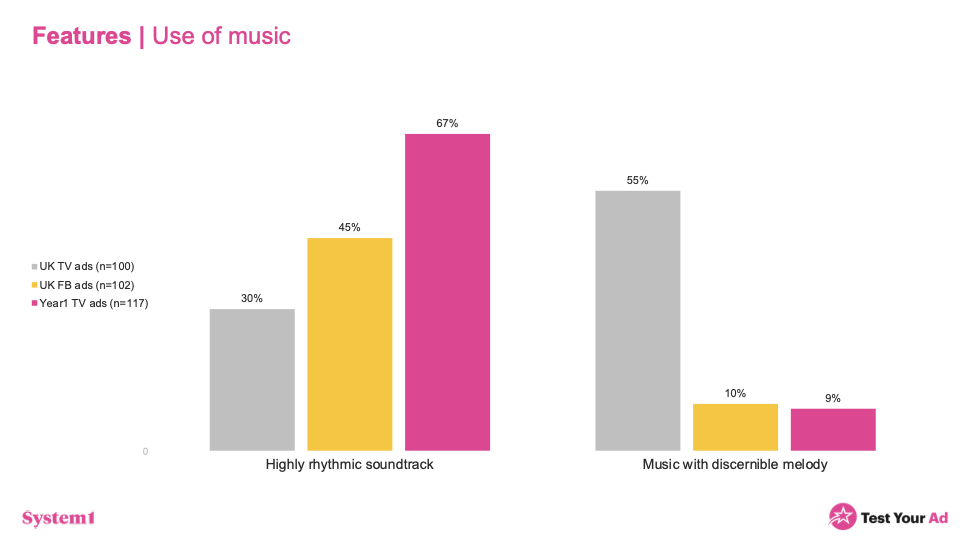
Music, proven to be a highly emotive feature of TV advertising and a major driver of creative effectiveness, looks like it’s being used far less effectively by new-to-TV advertisers. This could be because they’ve been prioritising it less for their Facebook and other videos where music is usually less of a feature, and have carried this habit over to TV. It could also be that new-to-TV advertisers are just spending far less on music – using more library tracks and generic sound-beds and fewer tracks with recognisable or familiar melodies.
Use of text
77% of our year1 new-to-TV ads featured prominent text on screen during the ad (and before the end-frame), compared to 67% of UK TV ads, and 91% of Facebook ads. So again we see ads by new-to-TV advertisers (pink) ‘looking’ more like Facebook ads (yellow) than the average TV ad (grey).

Here are some typical examples of this from the new-to-TV ads in our analysis, with text and graphics often being used extremely prominently:
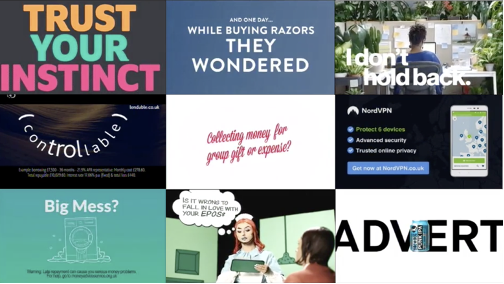
Another common feature of the ads in our data is that a high proportion focus on someone (very often female) addressing the viewer face-on and making a direct pitch to the audience. On paper this may seem like a good way to get and maintain attention, but our data suggests it’s not.

Another extremely common and dominant feature of the new-to-TV ads is the all-pervasive shot of an app or website in use. Admittedly it’s good practice to include a strong role for the brand or product in a commercial, as well as to build recognition of a brand’s visual identity, which means this is an understandable executional trope. But even allowing for all that, it’s hard to believe that the lack of imagination on show here is a driver of overall creative effectiveness, rather than a drain on it. At the very least more creative focus and imagination could be applied to the treatment of these shots.

In Peter Field’s work ‘Crisis in Creative Effectiveness in advertising’ (IPA 2019), he noted “Instead of emotionally engaging human stories that seek to charm and captivate, we are seeing more didactic, literal presentations that seek to prompt us into action”. And that’s exactly what you see in our analysis of 117 year1 ads by new-to-TV advertisers.
In Orlando Wood’s book ‘Lemon’ (IPA 2019), inspired by the work of psychiatrist, neuropsychologist and author Iain McGilchrist, Wood reviewed hundreds of UK TV ads from 1990-2018, and observed a decline in the use of character, storytelling, real world contexts, cultural references and other creative and imaginative elements. Conversely, he saw an increase in use of wall-to-wall voice overs, text, graphics, products and other imagery in close-up and free of any context. We saw exactly the same picture in our analysis of new-to-TV advertisers.
In the analysis for ‘Lemon’, features in ads were grouped and labelled as ‘left-brain’ or ‘right-brain’, with ‘left-brain’ features broadly being more rational, informative and detailed (text, words, close-ups, graphics etc) and ‘right-brain’ features broadly being more human, creative and ‘big picture’ (character, storytelling, melody etc).
| ‘Left-brain’ ad features | ‘Right-brain’ ad features |
| Lots of words on screen | Characters acting |
| Someone talking to camera | A story unfolding |
| A noticeable voiceover | Interaction between characters |
| Flat backdrops, basic studio sets | A recognisable place |
| Fast-cuts, split-screen effects | Discernible melody |
For ease of comparison in this analysis we grouped the executional features of our year1 ads in the same way. And whether or not you follow McGilchrist’s theories of brain localisation and how left and right hemispheres process things differently, you see a stark picture in terms of the way different ad features skew.
In our analysis, the average year1 ad contains 4.8 ‘left-brain’ features and only 1.5 ‘right-brain’ features, a skew to ‘left-brain’ features of 3.2. By comparison, established TV ads had a skew of 1.8, and Facebook ads had a skew of 2.7. So again on this measure, year1 ads (in pink) tend to have more in common with Facebook ads (yellow) than the average TV ad (grey).
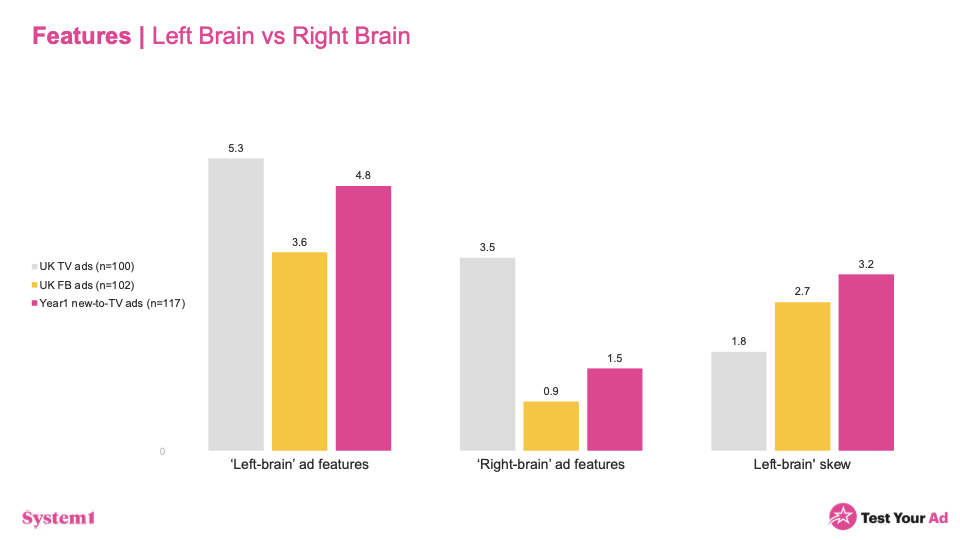
It could be that the lower TV production budgets available to new advertisers have a negative impact on creative effectiveness (I’ve long suspected there’s generally a correlation between TV production budget and effectiveness).
But it could also be that our data is picking up something more problematic in the long run: that techniques (including a heavy use of text and lack of music with melody) used by teams with more experience at making video content than making TV ads, are influencing TV creative and having a negative effect on effectiveness.
So what can scale-ups take away from all this?
TV and video advertising have an unparalleled ability to evoke emotion, attracting and maintaining attention and building long-term memories, which generate long-lasting sales effects.
But just putting any video on TV does not guarantee its emotional impact and these long-lasting effects. So approaching the development of TV creative in the same way you do your social or other video content could be a missed opportunity to unlock TV’s unique strengths – and growth.
The best TV and video advertising is executed in a way that can attract and hold attention and get a reaction from people. And the best ways to do that have been known for thousands of years: stories set in recognisable places, characters that interact with each other, stories that unfold in dramatic and surprising ways, music to amplify the emotional impact and drive the action.
In the early days of social media, the advice for advertisers was ‘don’t just put your TV ad on social’.
As social media and video content marketing reach maturity, and TV becomes the obvious next step for brands looking to scale, the converse of that advice seems to hold true: ‘don’t just put your online video on TV’.
[i] Thinkbox. This weekly reach figure excludes subscription VOD like Netflix and Amazon.
[ii] https://www.thinkbox.tv/research/thinkbox-research/demand-generation/
[iii] https://www.marketingweek.com/monzo-tv-ad-campaign/
[iv] Chart from Dan White’s Smart Marketing Book using data from ‘The Cost of Attention’ by Lumen Research https://www.lumen-research.com/blog/p653k3atys5ubp58jcydxoyn0d0wik
[vi] e.g. ITV’s initiative ‘Backing Business’ https://www.itvmedia.co.uk/itv-backing-business
[vii] ‘Why and how do founding entrepreneurs bond with their ventures? Neural correlates of entrepreneurial and parental bonding’, Lahti, Halko et al, The Journal of Business Venturing, May 2018 https://www.researchgate.net/publication/325341076_Why_and_how_do_founding_entrepreneurs_bond_with_their_ventures_Neural_correlates_of_entrepreneurial_and_parental_bonding
[viii] https://www.thinkbox.tv/case-studies/elizabeth-shaw/#download
[ix] We cut the full list of 193 down to 117 because we had a full dataset across all of System1’s metrics on this subset. [1] Lemon (IPA 2019, Orlando Wood), Achtung (IPA 2020, Orlando Wood).
[x] Lemon (IPA 2019, Orlando Wood), Achtung (IPA 2020, Orlando Wood).
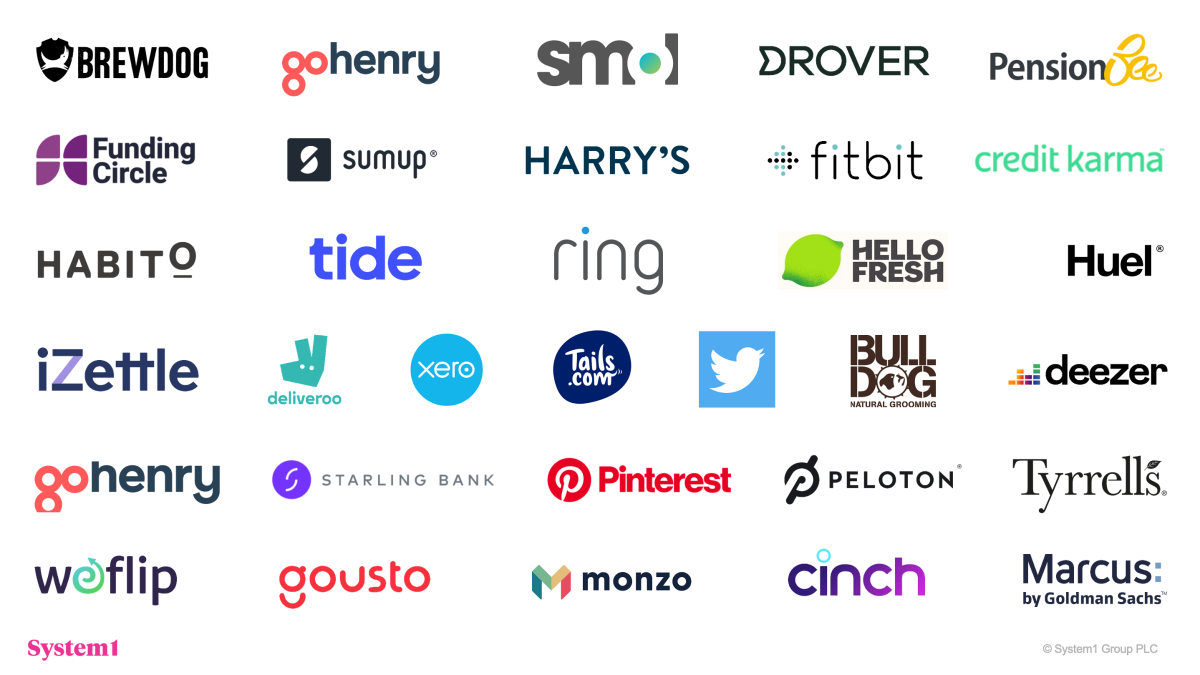
9 replies on “Scaling up without screwing up”
Is it easier to ‘be emotional’ with a brand you feel you know as opposed to a totally new brand? So response builds over 3/4 years as people relax into the brand and it’s ways? Whatever the creative?
LikeLike
The data doesn’t tell us anything about that, and there may be something in this, but I think mostly in ads/story-telling it’s extremely possible for new things, messages, learning to evoke emotional reactions from us. I think we all often conflate emotional reactions to ads (which are ideally intense to create strong memories) and the emotional responses we have to the brands we’re familiar with, which actually are surprisingly lacking: when you show people brands they ‘love’ the brain barely ‘lights up’ at all – you want your brand to become a ‘no-brainer’ when people are choosing it, rather than cause big reactions..
LikeLike
I think the main issue is that there is still a very outdated view of the “type” of TV advertising that drives efficient response, both in terms of the buying approach to the airtime and the creative approach of the ad itself. I think a lot of these brands seek out DRTV specialists in terms of buying and creative agencies and they all have a vested interest in not moving on in their thinking in the last 20-30 years. I have seen that a shift from traditional DRTV buying principles (from low interest, high frequency, to higher interest, low frequency/ higher reach spots) and a change to more emotionally engaging creative (without losing the informativeness or call to action of the ad), has been much more effective at driving total short term business outcomes.
LikeLike
Read this twice and thoroughly enjoyed it especially because it was rooted in evidenced-based rigour. Really interesting topic and I’ve never given thought as to what is the contributing factor to reduced effectiveness to new to TV advertisers and this was certainly thought provoking and enlightening. Great work
LikeLike
On the one hand, it will be odd if someone had a small ad in the local Yellow Pages and then move to a bill board campaign with the idea “let’s just enlarge the Yellow Pages ad”.
But looking at all the work on effectivity in advertising, it’s reasonable to assume that new entrants would make more mistakes than existing participants given that effectivity appears to be in decline.
LikeLike
Interesting, insightful and thorough – thanks to you and System 1.
LikeLike
[…] situation is mounting up. Tom Roach recently summarised what we know on the subject in his article Scaling up without screwing up, along with advice on how to get the first step into TV right. It’s a convincing […]
LikeLike
Insightful and inspiring as always, thank you Tom.
LikeLike
Summary: Show, don’t tell
LikeLike